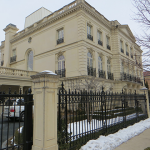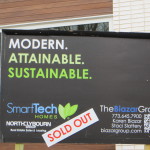Chicago’s North Burling Street, 2005-2015: From Public Housing to Mega-mansions
On Wednesday 30 March 2011, demolition began at 1230 North Burling Street, the last remaining high-rise block of public housing of the Cabrini-Green complex that, at its peak, had been home to over 15,000 people. The 23 high rise public housing blocks of Cabrini-Green, built between 1958 and 1962 and ranging from seven to nineteen floors in height, came to symbolize all that was bad about public housing, not just in Chicago but in the United States more generally. Cabrini-Green, like all of Chicago’s public housing, was conceived, designed, constructed and administered by the Chicago Housing Authority (CHA). In 1969 the CHA was found by the Supreme Court to have acted unconstitutionally in using race to determine where to build, and how to allocate apartments in, the city’s public housing projects. Within two decades of their completion, Cabrini-Green was notorious for its gangs and violence. In an effort to change this violent image of the Cabrini-Green projects, Mayor Jane Byrne spent a night in an apartment there in 1981. But horrific events continued after she moved out, like the shooting of seven-year-old Dantrell Davis in 1992, killed as he walked to school, and the 1997 rape of nine-year-old ‘Girl X.’ Yet less prominently featured in the media was the reality that Cabrini-Green was home to thousands of people. There was a community there: friendships, relationships, multi-generational families, memories, sports teams, schools, small businesses and a church. Today this is all gone.
In 2000 the CHA announced its $1.5bn Plan for Transformation that aimed to raze over fifty public housing high rises city-wide and relocate almost 35,000 people. A year later in 2001 demolition began on the Cabrini-Green high rises whose occupants, at the time, were almost 100% African-American. Residents protested again the destruction of their community and groups like the Coalition to Protect Public Housing led efforts to pressure the City and CHA to stop the demolitions and recognize housing as a human right. The City responded with Section 8 housing vouchers for some Cabrini-Green residents, a promise to keep “affordable” some of the new condominiums being built following the demolitions, and offered former residents a ‘right to return’ to new or rehabbed CHA properties. But demand outstripped supply, and there has just not been enough housing provided to meet the needs of the thousands who left Cabrini-Green. Most former residents have moved into Chicago’s poorest, most violent and under-served neighborhoods on Chicago’s south and west sides, others have moved beyond the city. Very few have found alternative housing in the neighborhood they once called home.



As the Cabrini-Green enclave of public housing on Chicago’s otherwise wealthy near north side was being removed, a new phenomenon was occurring just a few blocks further along North Burling Street. About a mile away from Cabrini-Green, property addressed between 1800-2000 North Burling was also being fundamentally transformed in the mid-2000s. An area of late-Nineteenth Century houses and two-flats, these were bring bought and torn down as buyers sought to purchase multiple adjacent lots to enable the construction of palatial mansions. Built in 2009 with around 26,000 sq. ft. of floor space, the 12 bedroom, 10 bathroom house at 1932 North Burling epitomizes this type of development. Numerous other examples of multi-million dollar homes now line North Burling as some of Chicago’s wealthiest residents and best known philanthropists have moved in. A century ago, this area of Chicago housed German immigrants and their descendents; over a generation ago it began gentrifying, but the demolition of Cabrini-Green seem to unleash an ever more rapacious real estate market on North Burling. Mega-mansions adorned with classical columns, pilasters, ironwork, and numerous other flourishes were built and the sidewalk and curbs are now cut at regular intervals to allow access to below street garages. The last few remaining Victorian cottages, such as 1832 North Burling, will likely soon be torn down and replaced by another new multi-million dollar mansion on the block.
Now that the high rises have gone from Cabrini-Green, and with them their residents, the land on which the public housing project once stood has become highly valued real estate. As if to emphasize the changing urban geography and public policy priorities of Chicago, in 2013 Target opened its latest Chicago superstore on the footprint of one of the Cabrini-Green high rises. On the northern edge of the Cabrini-Green site, a luxury retail, entertainment and residential complex is currently under construction. Built by Structured Development, LLC, and scheduled to open in Fall 2015, “NewCity” will bring 370,000 sq. ft. of retail, a multiplex movie theater, a bowling alley and 200 of the most expensive rental apartments in Chicago, all under environmentally friendly green roofs. The website advertising NewCity, “a hot, new destination… Its landscaped design invites you to shop, dine alfresco or strike up a conversation in view of the dynamic water feature,” depicts attractive young people (one couple holding a smiling toddler), sushi, shopping bags, and a cute bulldog. Promising “one of the most vibrant neighborhoods in America,” where “fashionista meet[s] foodie” and “modern amenities, great shops and the ultimate in style inside and out, NewCity is where hip meets high standards.” It is ironic that Chicago already has a community called New City: south of the Chicago River and once home of the meatpacking stockyards and their immigrant labor force made famous in Upton Sinclair’s The Jungle over a century ago (an area that too, is now much transformed).
Some traces of Cabrini-Green remain. There are footpaths that lead to nowhere, pipes and wires occasionally protrude from concrete slabs surrounded by grass, and gaps in fences show where thousands of people once walked from the Division Street sidewalk to their high rise home. Like the low income residents who once lived there, however, these too will soon be gone: replaced by a new vision of North Burling, of NewCity, of a new Chicago: one that is high-cost, offering luxury lifestyles for those able to afford them, and little remaining for those who cannot.
—Euan Hague
DePaul University


